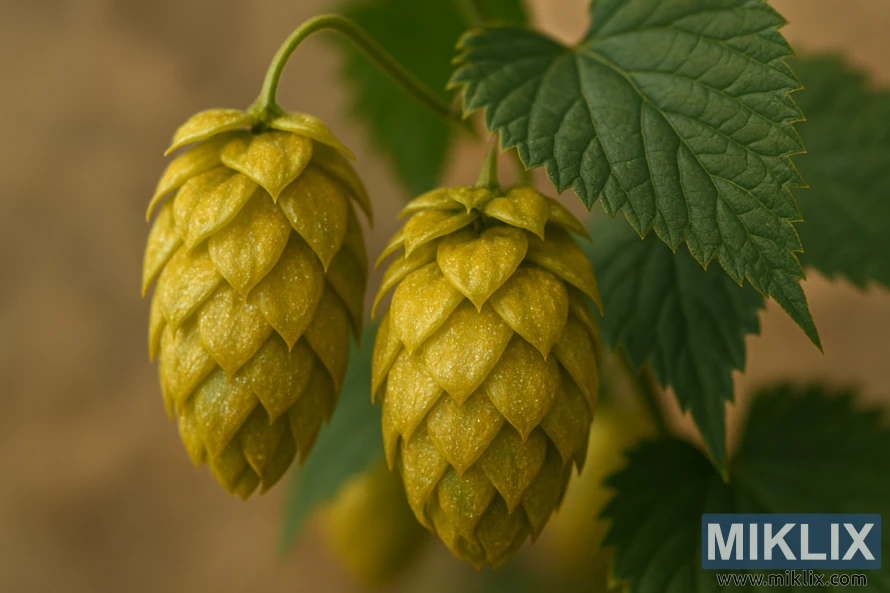Image: Golden-Green Amallia Hop Cones
Published: September 29, 2025 at 8:54:11 PM UTC
A close-up of resinous Amallia hop cones shows golden-green bracts and sparkling alpha acid crystals, highlighting their brewing potency.
This photograph presents a vivid, high-resolution close-up of several mature Amallia hop cones, with an emphasis on their distinctive golden-green hues and botanical complexity. Captured in landscape orientation, the image isolates the hops in a way that draws attention to their aesthetic beauty and their importance as a brewing ingredient, particularly in the context of alpha and beta acid profiles.
In the foreground, three plump, resinous hop cones dominate the composition. Their shapes are compact and ovate, resembling the scales of a small pinecone but with a far more delicate texture. Each cone is constructed from overlapping bracts, which are tightly layered and covered in a fine crystalline sheen. These glistening particles are alpha acid crystals—a visual testament to the hop’s brewing potency. The crystalline texture catches the ambient light and sparkles subtly, creating the impression of a freshly harvested, oil-rich crop.
The color palette of the cones is particularly striking. A gradient of pale lime green to golden amber sweeps across their surfaces, indicating ripeness and optimal oil content. The bracts themselves appear to have fine, vein-like ridges, and some areas show subtle signs of translucency, allowing glimpses of the lupulin glands nestled within. These glands—tiny, golden-yellow nodules packed with essential oils and resins—are only partially visible but implied by the glow and gloss on the cone surfaces.
Adjacent to the cones, the middle ground of the image reveals a series of hop leaves. These leaves are broad and sharply serrated, with a deep green color and prominent veining that adds a dimensional counterbalance to the smooth, layered cones. Their placement in the composition is intentional, serving as a textural and chromatic foil to the warm tones of the cones while adding depth and grounding the image in its natural botanical setting.
The background is beautifully blurred with a neutral tone, likely an earthy beige or soft brown, rendered through a shallow depth of field. This minimalist backdrop does not compete with the primary subject matter, allowing the viewer’s eye to remain fixed on the complex structure and chemistry of the hop cones themselves.
The lighting throughout the image is soft and diffused, likely from natural sunlight filtered through a clouded sky or translucent canopy. The warm, indirect light enhances the natural color variation in the cones and casts gentle shadows that emphasize their three-dimensionality. The result is an inviting, slightly glowing atmosphere that suggests the ripeness of late summer and the importance of precise timing in hop harvesting.
Conceptually, the photograph encapsulates the essence of brewing science. The visible alpha acid crystals and implied beta acid content signify the vital role of hops in contributing bitterness, aroma, and preservation to beer. By focusing on the microstructure of the cone—its bracts, lupulin glands, and resin deposits—the image becomes not just a work of botanical portraiture, but a visual representation of chemical potential.
The overall composition achieves a balance between scientific clarity and artistic elegance. It invites both the hop enthusiast and the casual observer to pause and appreciate the intricacy of this unassuming but powerful flower. With its golden hues, rich textures, and thoughtful lighting, the image stands as a tribute to one of the most iconic ingredients in brewing.
The image is related to: Hops in Beer Brewing: Amallia

